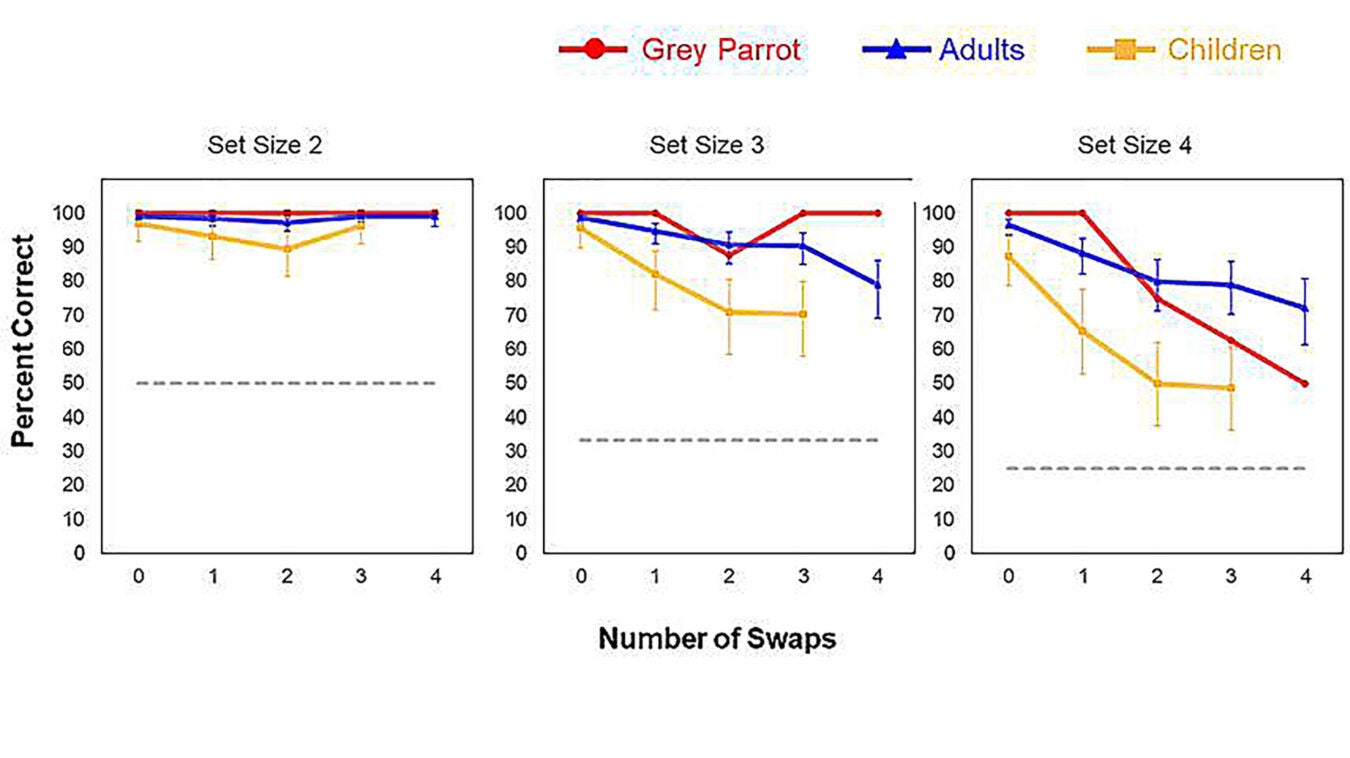From The Harvard Gazette:
When a bird brain tops Harvard students on a test
Experiment tests human vs. parrot memory in a complex shell game
What happens when an African grey parrot goes head-to-head with 21 Harvard students in a test measuring a type of visual memory? Put simply: The parrot moves to the head of the class.
Harvard researchers compared how 21 human adults and 21 6- to 8-year-old children stacked up against an African grey parrot named Griffin in a complex version of the classic shell game.
It worked like this: Tiny colored pom-poms were covered with cups and then shuffled, so participants had to track which object was under which cup. The experimenter then showed them a pom-pom that matched one of the same color hidden under one of the cups and asked them to point at the cup. (Griffin, of course, used his beak to point.) The participants were tested on tracking two, three, and four different-colored pom-poms. The position of the cups were swapped zero to four times for each of those combinations. Griffin and the students did 120 trials; the children did 36.
The game tests the brain’s ability to retain memory of items that are no longer in view, and then updating when faced with new information, like a change in location. This cognitive system is known as visual working memory and is the one of the foundations for intelligent behavior.
So how did the parrot fare? Griffin outperformed the 6- to 8-year-olds across all levels on average, and he performed either as well as or slightly better than the 21 Harvard undergraduates on 12 of the 14 of trial types.
That’s not bad at all for a so-called bird brain.
Courtesy of Hrag Pailian and Irene Pepperberg

“Think about it: Grey parrot outperforms Harvard undergrads. That’s pretty freaking awesome,” said Hrag Pailian, the postdoctoral fellow at the Graduate School of Arts and Sciences who led the experiment. “We had students concentrating in engineering, pre-meds, this, that, seniors, and he just kicked their butts.”
Full disclosure: Griffin has been the star of past cognitive studies, like showing he’s smarter than the typical 4-year-old and as intelligent as a 6- to 8-year-old child. But making Harvard students do a double take on their own intelligence is quite the step up.
To be fair, the Harvard students did manage to keep (some) of their Crimson pride intact. On the final two tests, which involved the most items and the most movement, the adults had the clear edge. Griffin’s average dipped toward the children’s performance — though never below it. The researchers were unable to determine the precise reason for this drop, but they believe it has something to do with the way human intelligence works (arguably making the Harvard students’ victory a matter of performance enhancement of the genetic variety)....
....MUCH MORE
Yeah, the young urban troubadours playing the shell game would beat 'em all, take the undergrad's money and the bird's cuttlebone to boot.
Somehow related:
Commodity traders superior to chimpanzees, research shows
Just a reminder.
A repost from 2008.
I made a serious career track mistake.
Years ago a counselor pointed out that I seemed to have an affinity for animals (It's true. Kids and dogs like me. So do drunks and and folks suffering from various psychopathologies).
Had I followed up on her thinking I would now be tenured, trading outside my species and living the grant-proposal dream.
From RISK Over the Counter:
In a radical overturning of conventional wisdom, scientists in Georgia and California have found significant differences between commodity traders and chimpanzees. Chimps are, in fact, not very good at commodity trading:
the researchers found that chimpanzees often did not spontaneously barter food items, but needed to be trained to engage in commodity barter. Moreover, even after the chimpanzees had been trained to do barters with reliable human trading partners, they were reluctant to engage in extreme deals in which a very good commodity (apple slices) had to be sacrificed in order to get an even more preferred commodity (grapes)...The report becomes particularly readable when it speculates on the reasons why:because of their lack of property ownership norms...See also:
...or, for that matter, pockets.... ...chimpanzees in nature do not store property and thus would have little opportunity to trade commodities....MORE
Jim Cramer beats Monkey in Stock Picking Contes